Organic and Non-Organic Foods: A Detailed Nutritional Comparison Essay
VerifiedAdded on 2020/05/03
|8
|2089
|382
Essay
AI Summary
This essay provides a detailed comparison of the nutritional content of organic and non-organic foods. It begins by defining organic and non-organic farming practices, highlighting the use of natural fertilizers versus chemical pesticides and preservatives. The essay then explores the nutritional differences, arguing that organic foods contain higher levels of vitamins, antioxidants, and beneficial fatty acids like omega-3s. It also notes the lower levels of nitrates and the presence of salicylic acid in organic foods. Conversely, the essay discusses the negative impacts of non-organic foods, including lower nutrient levels, the presence of harmful pesticides, and the potential health risks associated with food additives like nitrates. The author concludes that organic foods are a better source of nutrition and contribute to overall health and well-being, while non-organic foods may pose risks due to chemical exposure and reduced nutrient content. The essay uses multiple research sources to support its claims.
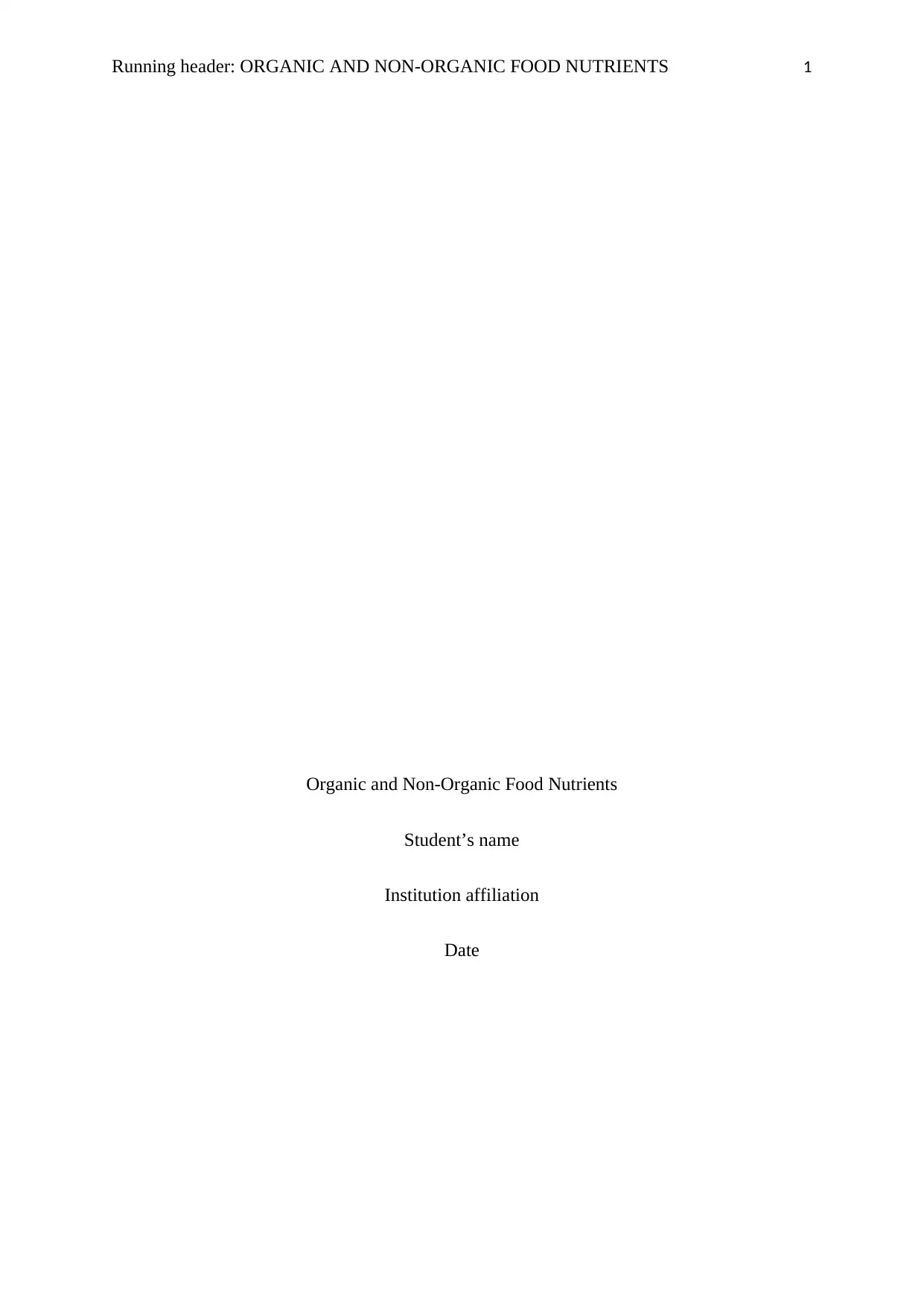
Running header: ORGANIC AND NON-ORGANIC FOOD NUTRIENTS 1
Organic and Non-Organic Food Nutrients
Student’s name
Institution affiliation
Date
Organic and Non-Organic Food Nutrients
Student’s name
Institution affiliation
Date
Paraphrase This Document
Need a fresh take? Get an instant paraphrase of this document with our AI Paraphraser
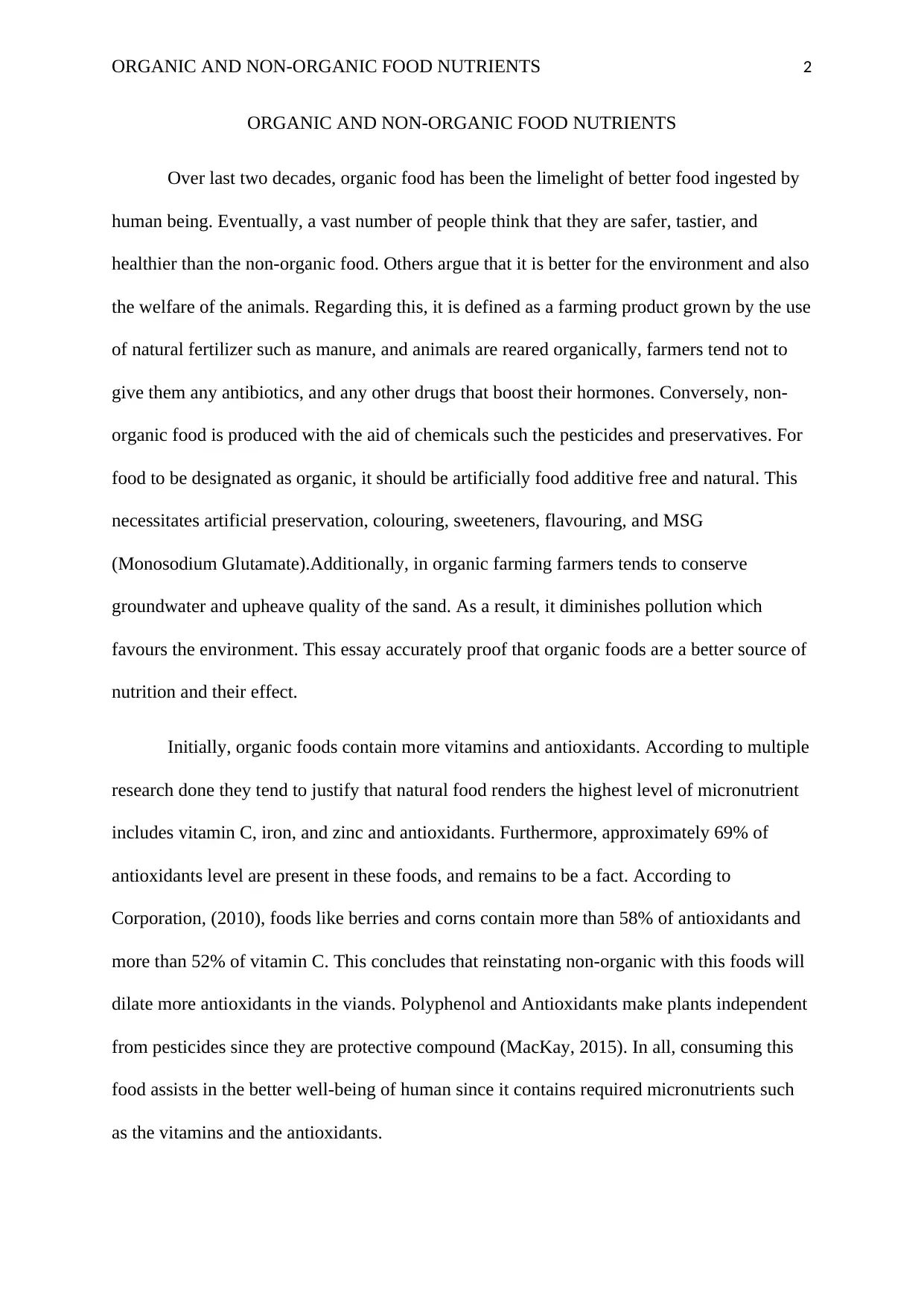
ORGANIC AND NON-ORGANIC FOOD NUTRIENTS 2
ORGANIC AND NON-ORGANIC FOOD NUTRIENTS
Over last two decades, organic food has been the limelight of better food ingested by
human being. Eventually, a vast number of people think that they are safer, tastier, and
healthier than the non-organic food. Others argue that it is better for the environment and also
the welfare of the animals. Regarding this, it is defined as a farming product grown by the use
of natural fertilizer such as manure, and animals are reared organically, farmers tend not to
give them any antibiotics, and any other drugs that boost their hormones. Conversely, non-
organic food is produced with the aid of chemicals such the pesticides and preservatives. For
food to be designated as organic, it should be artificially food additive free and natural. This
necessitates artificial preservation, colouring, sweeteners, flavouring, and MSG
(Monosodium Glutamate).Additionally, in organic farming farmers tends to conserve
groundwater and upheave quality of the sand. As a result, it diminishes pollution which
favours the environment. This essay accurately proof that organic foods are a better source of
nutrition and their effect.
Initially, organic foods contain more vitamins and antioxidants. According to multiple
research done they tend to justify that natural food renders the highest level of micronutrient
includes vitamin C, iron, and zinc and antioxidants. Furthermore, approximately 69% of
antioxidants level are present in these foods, and remains to be a fact. According to
Corporation, (2010), foods like berries and corns contain more than 58% of antioxidants and
more than 52% of vitamin C. This concludes that reinstating non-organic with this foods will
dilate more antioxidants in the viands. Polyphenol and Antioxidants make plants independent
from pesticides since they are protective compound (MacKay, 2015). In all, consuming this
food assists in the better well-being of human since it contains required micronutrients such
as the vitamins and the antioxidants.
ORGANIC AND NON-ORGANIC FOOD NUTRIENTS
Over last two decades, organic food has been the limelight of better food ingested by
human being. Eventually, a vast number of people think that they are safer, tastier, and
healthier than the non-organic food. Others argue that it is better for the environment and also
the welfare of the animals. Regarding this, it is defined as a farming product grown by the use
of natural fertilizer such as manure, and animals are reared organically, farmers tend not to
give them any antibiotics, and any other drugs that boost their hormones. Conversely, non-
organic food is produced with the aid of chemicals such the pesticides and preservatives. For
food to be designated as organic, it should be artificially food additive free and natural. This
necessitates artificial preservation, colouring, sweeteners, flavouring, and MSG
(Monosodium Glutamate).Additionally, in organic farming farmers tends to conserve
groundwater and upheave quality of the sand. As a result, it diminishes pollution which
favours the environment. This essay accurately proof that organic foods are a better source of
nutrition and their effect.
Initially, organic foods contain more vitamins and antioxidants. According to multiple
research done they tend to justify that natural food renders the highest level of micronutrient
includes vitamin C, iron, and zinc and antioxidants. Furthermore, approximately 69% of
antioxidants level are present in these foods, and remains to be a fact. According to
Corporation, (2010), foods like berries and corns contain more than 58% of antioxidants and
more than 52% of vitamin C. This concludes that reinstating non-organic with this foods will
dilate more antioxidants in the viands. Polyphenol and Antioxidants make plants independent
from pesticides since they are protective compound (MacKay, 2015). In all, consuming this
food assists in the better well-being of human since it contains required micronutrients such
as the vitamins and the antioxidants.
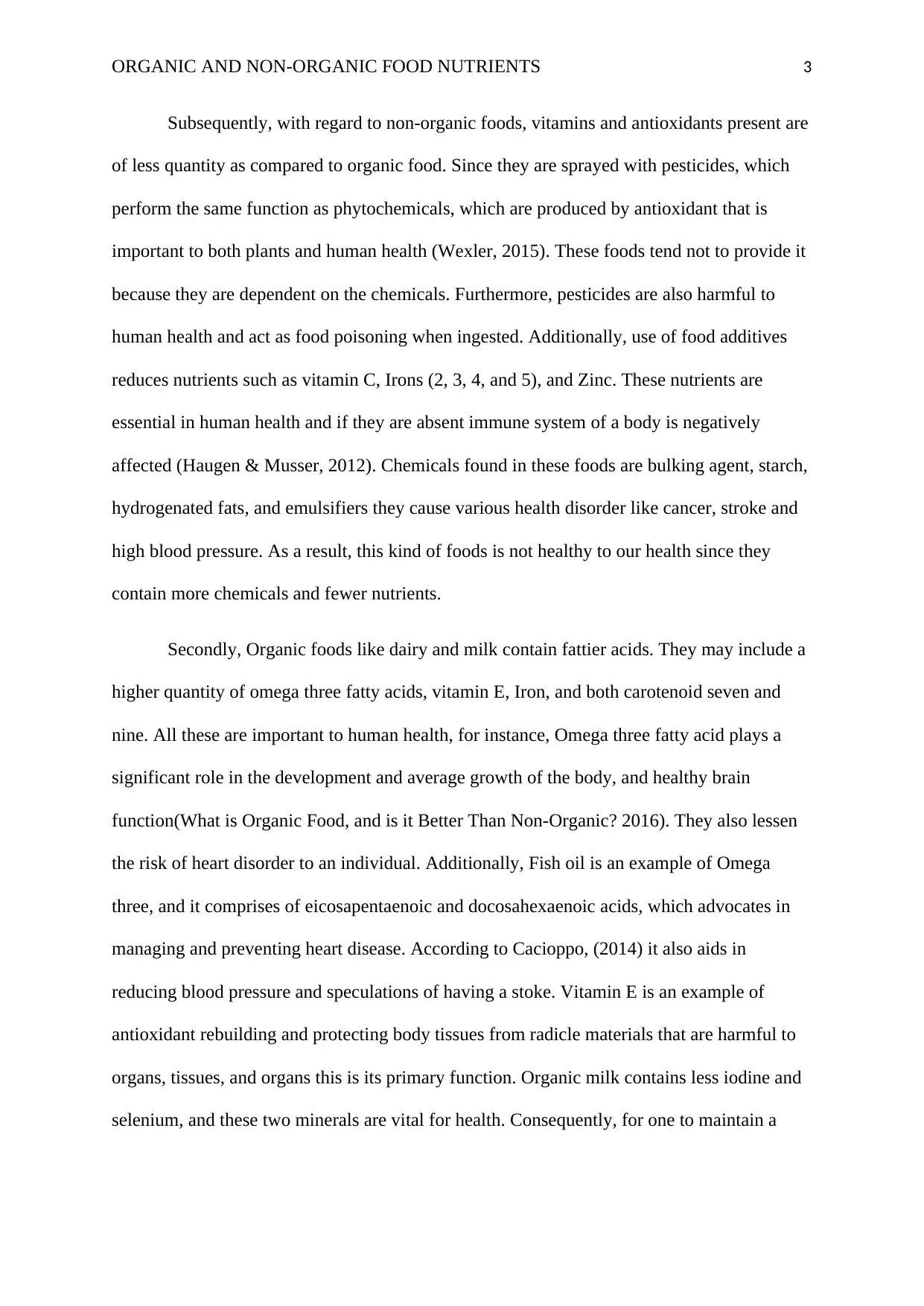
ORGANIC AND NON-ORGANIC FOOD NUTRIENTS 3
Subsequently, with regard to non-organic foods, vitamins and antioxidants present are
of less quantity as compared to organic food. Since they are sprayed with pesticides, which
perform the same function as phytochemicals, which are produced by antioxidant that is
important to both plants and human health (Wexler, 2015). These foods tend not to provide it
because they are dependent on the chemicals. Furthermore, pesticides are also harmful to
human health and act as food poisoning when ingested. Additionally, use of food additives
reduces nutrients such as vitamin C, Irons (2, 3, 4, and 5), and Zinc. These nutrients are
essential in human health and if they are absent immune system of a body is negatively
affected (Haugen & Musser, 2012). Chemicals found in these foods are bulking agent, starch,
hydrogenated fats, and emulsifiers they cause various health disorder like cancer, stroke and
high blood pressure. As a result, this kind of foods is not healthy to our health since they
contain more chemicals and fewer nutrients.
Secondly, Organic foods like dairy and milk contain fattier acids. They may include a
higher quantity of omega three fatty acids, vitamin E, Iron, and both carotenoid seven and
nine. All these are important to human health, for instance, Omega three fatty acid plays a
significant role in the development and average growth of the body, and healthy brain
function(What is Organic Food, and is it Better Than Non-Organic? 2016). They also lessen
the risk of heart disorder to an individual. Additionally, Fish oil is an example of Omega
three, and it comprises of eicosapentaenoic and docosahexaenoic acids, which advocates in
managing and preventing heart disease. According to Cacioppo, (2014) it also aids in
reducing blood pressure and speculations of having a stoke. Vitamin E is an example of
antioxidant rebuilding and protecting body tissues from radicle materials that are harmful to
organs, tissues, and organs this is its primary function. Organic milk contains less iodine and
selenium, and these two minerals are vital for health. Consequently, for one to maintain a
Subsequently, with regard to non-organic foods, vitamins and antioxidants present are
of less quantity as compared to organic food. Since they are sprayed with pesticides, which
perform the same function as phytochemicals, which are produced by antioxidant that is
important to both plants and human health (Wexler, 2015). These foods tend not to provide it
because they are dependent on the chemicals. Furthermore, pesticides are also harmful to
human health and act as food poisoning when ingested. Additionally, use of food additives
reduces nutrients such as vitamin C, Irons (2, 3, 4, and 5), and Zinc. These nutrients are
essential in human health and if they are absent immune system of a body is negatively
affected (Haugen & Musser, 2012). Chemicals found in these foods are bulking agent, starch,
hydrogenated fats, and emulsifiers they cause various health disorder like cancer, stroke and
high blood pressure. As a result, this kind of foods is not healthy to our health since they
contain more chemicals and fewer nutrients.
Secondly, Organic foods like dairy and milk contain fattier acids. They may include a
higher quantity of omega three fatty acids, vitamin E, Iron, and both carotenoid seven and
nine. All these are important to human health, for instance, Omega three fatty acid plays a
significant role in the development and average growth of the body, and healthy brain
function(What is Organic Food, and is it Better Than Non-Organic? 2016). They also lessen
the risk of heart disorder to an individual. Additionally, Fish oil is an example of Omega
three, and it comprises of eicosapentaenoic and docosahexaenoic acids, which advocates in
managing and preventing heart disease. According to Cacioppo, (2014) it also aids in
reducing blood pressure and speculations of having a stoke. Vitamin E is an example of
antioxidant rebuilding and protecting body tissues from radicle materials that are harmful to
organs, tissues, and organs this is its primary function. Organic milk contains less iodine and
selenium, and these two minerals are vital for health. Consequently, for one to maintain a
⊘ This is a preview!⊘
Do you want full access?
Subscribe today to unlock all pages.

Trusted by 1+ million students worldwide

ORGANIC AND NON-ORGANIC FOOD NUTRIENTS 4
good state of health one should assure that take organic dairy and milk since they contain
nutrients that play a notable role in body subsistence.
However, non-organic dairy and milk contain less fatty acids or sometimes they may
lack this acid. The Less fatty acid in the body may lead to high risk of the organ not
functioning as required? Such risks include amnesia, dementia, vision problem, skin and hair
problems, and mood swings. Additionally, most of the patients who have Alzheimer's and
diagnosed with ADHD have lower than the standard level of vital fatty acids concluding that
they are taking in convenctional foods. According to Haugen & Musser, (2012), there is no
specific quantity of fatty acid in a diet, but it is recommended to take up to five to six percent
of fat per day, on the contrary, this kind of food has less than five percent. Moreover, this
proves to be harmful to health since it contains less amount of fatty acid (omega three fatty
acids, vitamin E, Iron, and both carotenoid seven and nine.). As a result, health disorders are
triggered by this diet, and some disease may evolve from it because for a body to protect its
self-becomes more cumbersome since nutrient that performs this function are of less quantity.
Thirdly, level of nitrates in organic food is generally low, which is medically
amalgamated product thus makes it exceptional. The concentration of nitrate in this diet is
less than thirty percent. The low rate of nitrate in the body remains to be less harmful to
human health, and high level of it may increase the risk of specific disorders like cancer.
When it is mixed with water, they are converted to nitric oxide which limits the risks of
hypertension. Another function is that it can reverse or prevent chest pain, and angina
triggered when the heart muscle does not get ample oxygen (Domazet & Djokić, 2018).
Moreover, nitrate helps in making an amino acid, which in the process are required to make
proteins. Talking of proteins, they are the primary component of the entire organ; it is used by
the body to repair and reconstruct the worn out tissues. Also, it also assists in building
hormones, enzymes, and other body chemicals that maintain the metabolic rate (Wrolstad,
good state of health one should assure that take organic dairy and milk since they contain
nutrients that play a notable role in body subsistence.
However, non-organic dairy and milk contain less fatty acids or sometimes they may
lack this acid. The Less fatty acid in the body may lead to high risk of the organ not
functioning as required? Such risks include amnesia, dementia, vision problem, skin and hair
problems, and mood swings. Additionally, most of the patients who have Alzheimer's and
diagnosed with ADHD have lower than the standard level of vital fatty acids concluding that
they are taking in convenctional foods. According to Haugen & Musser, (2012), there is no
specific quantity of fatty acid in a diet, but it is recommended to take up to five to six percent
of fat per day, on the contrary, this kind of food has less than five percent. Moreover, this
proves to be harmful to health since it contains less amount of fatty acid (omega three fatty
acids, vitamin E, Iron, and both carotenoid seven and nine.). As a result, health disorders are
triggered by this diet, and some disease may evolve from it because for a body to protect its
self-becomes more cumbersome since nutrient that performs this function are of less quantity.
Thirdly, level of nitrates in organic food is generally low, which is medically
amalgamated product thus makes it exceptional. The concentration of nitrate in this diet is
less than thirty percent. The low rate of nitrate in the body remains to be less harmful to
human health, and high level of it may increase the risk of specific disorders like cancer.
When it is mixed with water, they are converted to nitric oxide which limits the risks of
hypertension. Another function is that it can reverse or prevent chest pain, and angina
triggered when the heart muscle does not get ample oxygen (Domazet & Djokić, 2018).
Moreover, nitrate helps in making an amino acid, which in the process are required to make
proteins. Talking of proteins, they are the primary component of the entire organ; it is used by
the body to repair and reconstruct the worn out tissues. Also, it also assists in building
hormones, enzymes, and other body chemicals that maintain the metabolic rate (Wrolstad,
Paraphrase This Document
Need a fresh take? Get an instant paraphrase of this document with our AI Paraphraser
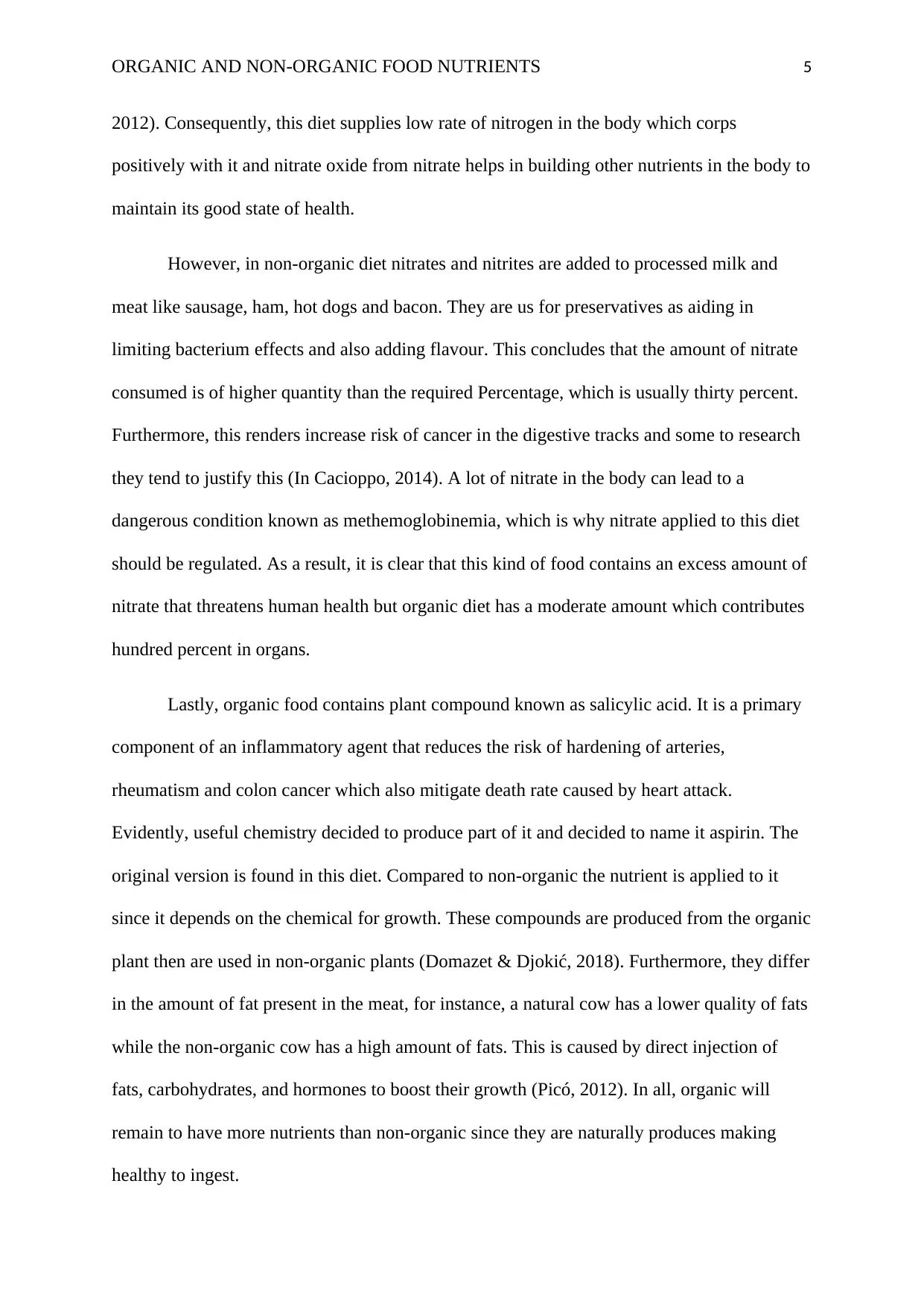
ORGANIC AND NON-ORGANIC FOOD NUTRIENTS 5
2012). Consequently, this diet supplies low rate of nitrogen in the body which corps
positively with it and nitrate oxide from nitrate helps in building other nutrients in the body to
maintain its good state of health.
However, in non-organic diet nitrates and nitrites are added to processed milk and
meat like sausage, ham, hot dogs and bacon. They are us for preservatives as aiding in
limiting bacterium effects and also adding flavour. This concludes that the amount of nitrate
consumed is of higher quantity than the required Percentage, which is usually thirty percent.
Furthermore, this renders increase risk of cancer in the digestive tracks and some to research
they tend to justify this (In Cacioppo, 2014). A lot of nitrate in the body can lead to a
dangerous condition known as methemoglobinemia, which is why nitrate applied to this diet
should be regulated. As a result, it is clear that this kind of food contains an excess amount of
nitrate that threatens human health but organic diet has a moderate amount which contributes
hundred percent in organs.
Lastly, organic food contains plant compound known as salicylic acid. It is a primary
component of an inflammatory agent that reduces the risk of hardening of arteries,
rheumatism and colon cancer which also mitigate death rate caused by heart attack.
Evidently, useful chemistry decided to produce part of it and decided to name it aspirin. The
original version is found in this diet. Compared to non-organic the nutrient is applied to it
since it depends on the chemical for growth. These compounds are produced from the organic
plant then are used in non-organic plants (Domazet & Djokić, 2018). Furthermore, they differ
in the amount of fat present in the meat, for instance, a natural cow has a lower quality of fats
while the non-organic cow has a high amount of fats. This is caused by direct injection of
fats, carbohydrates, and hormones to boost their growth (Picó, 2012). In all, organic will
remain to have more nutrients than non-organic since they are naturally produces making
healthy to ingest.
2012). Consequently, this diet supplies low rate of nitrogen in the body which corps
positively with it and nitrate oxide from nitrate helps in building other nutrients in the body to
maintain its good state of health.
However, in non-organic diet nitrates and nitrites are added to processed milk and
meat like sausage, ham, hot dogs and bacon. They are us for preservatives as aiding in
limiting bacterium effects and also adding flavour. This concludes that the amount of nitrate
consumed is of higher quantity than the required Percentage, which is usually thirty percent.
Furthermore, this renders increase risk of cancer in the digestive tracks and some to research
they tend to justify this (In Cacioppo, 2014). A lot of nitrate in the body can lead to a
dangerous condition known as methemoglobinemia, which is why nitrate applied to this diet
should be regulated. As a result, it is clear that this kind of food contains an excess amount of
nitrate that threatens human health but organic diet has a moderate amount which contributes
hundred percent in organs.
Lastly, organic food contains plant compound known as salicylic acid. It is a primary
component of an inflammatory agent that reduces the risk of hardening of arteries,
rheumatism and colon cancer which also mitigate death rate caused by heart attack.
Evidently, useful chemistry decided to produce part of it and decided to name it aspirin. The
original version is found in this diet. Compared to non-organic the nutrient is applied to it
since it depends on the chemical for growth. These compounds are produced from the organic
plant then are used in non-organic plants (Domazet & Djokić, 2018). Furthermore, they differ
in the amount of fat present in the meat, for instance, a natural cow has a lower quality of fats
while the non-organic cow has a high amount of fats. This is caused by direct injection of
fats, carbohydrates, and hormones to boost their growth (Picó, 2012). In all, organic will
remain to have more nutrients than non-organic since they are naturally produces making
healthy to ingest.

ORGANIC AND NON-ORGANIC FOOD NUTRIENTS 6
In conclusion, according to the research organic foods comprise all nutrients that help
in maintaining healthy body function. Some nutrients help in sustaining body immune to fight
diseases. Contrarily, the non-organic food contains a lot of chemicals than the nutrients. If an
individual ingests it, high chances of them suffering from health disorders such as heart
disorders, stroke, and reduced body immune. Before ingesting any food one should take note
of what taken to reduce the risks. Unfortunately, there is evidence that proofs that organic
food serves the primary function in maintaining human health while also proving the adverse
effect of non-organic foods. Consequently, for a person to get required nutrients, one should
avoid non-organic diet to reduce the low rate of taking in chemicals.
In conclusion, according to the research organic foods comprise all nutrients that help
in maintaining healthy body function. Some nutrients help in sustaining body immune to fight
diseases. Contrarily, the non-organic food contains a lot of chemicals than the nutrients. If an
individual ingests it, high chances of them suffering from health disorders such as heart
disorders, stroke, and reduced body immune. Before ingesting any food one should take note
of what taken to reduce the risks. Unfortunately, there is evidence that proofs that organic
food serves the primary function in maintaining human health while also proving the adverse
effect of non-organic foods. Consequently, for a person to get required nutrients, one should
avoid non-organic diet to reduce the low rate of taking in chemicals.
⊘ This is a preview!⊘
Do you want full access?
Subscribe today to unlock all pages.

Trusted by 1+ million students worldwide
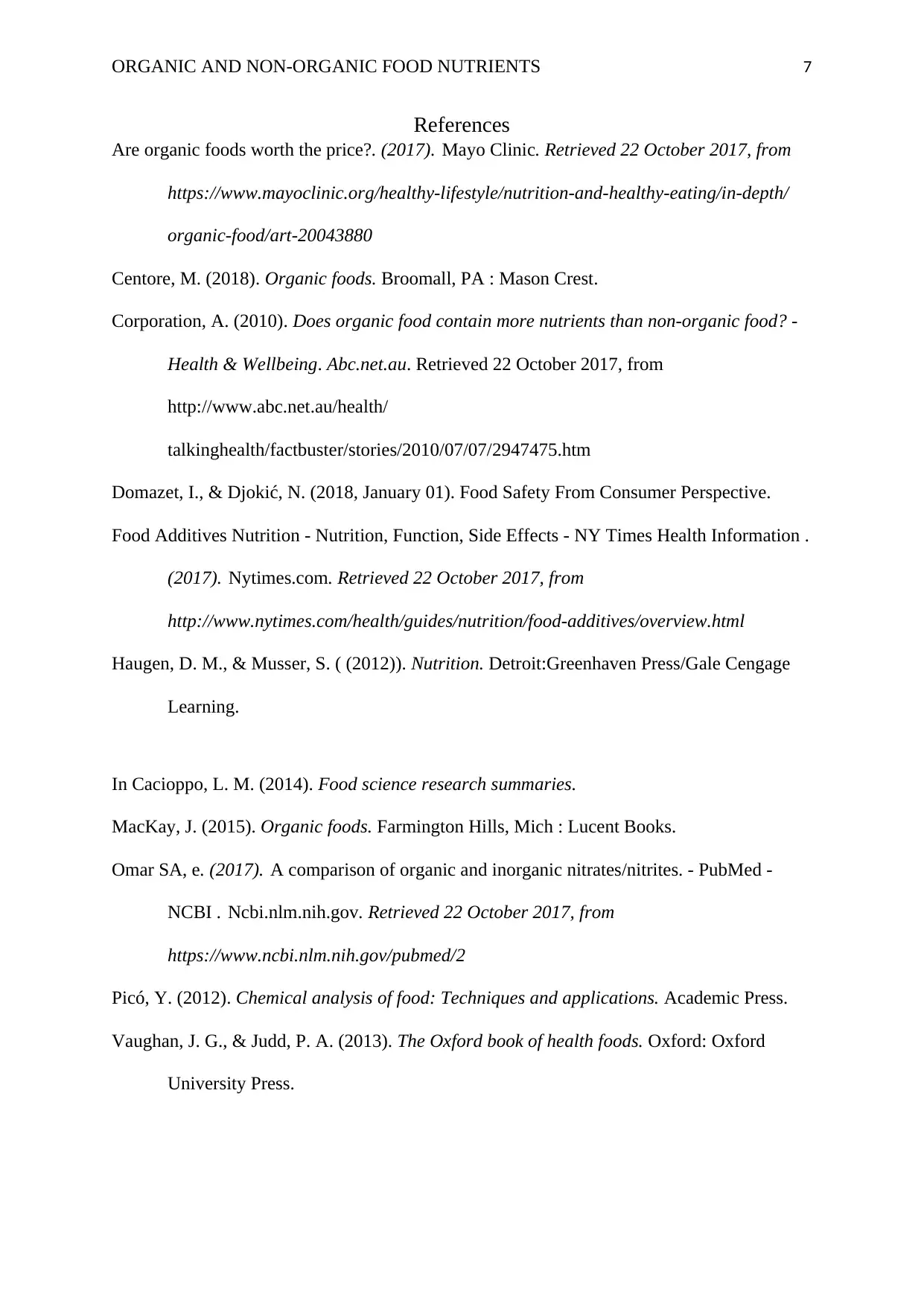
ORGANIC AND NON-ORGANIC FOOD NUTRIENTS 7
References
Are organic foods worth the price?. (2017). Mayo Clinic. Retrieved 22 October 2017, from
https://www.mayoclinic.org/healthy-lifestyle/nutrition-and-healthy-eating/in-depth/
organic-food/art-20043880
Centore, M. (2018). Organic foods. Broomall, PA : Mason Crest.
Corporation, A. (2010). Does organic food contain more nutrients than non-organic food? -
Health & Wellbeing. Abc.net.au. Retrieved 22 October 2017, from
http://www.abc.net.au/health/
talkinghealth/factbuster/stories/2010/07/07/2947475.htm
Domazet, I., & Djokić, N. (2018, January 01). Food Safety From Consumer Perspective.
Food Additives Nutrition - Nutrition, Function, Side Effects - NY Times Health Information .
(2017). Nytimes.com. Retrieved 22 October 2017, from
http://www.nytimes.com/health/guides/nutrition/food-additives/overview.html
Haugen, D. M., & Musser, S. ( (2012)). Nutrition. Detroit:Greenhaven Press/Gale Cengage
Learning.
In Cacioppo, L. M. (2014). Food science research summaries.
MacKay, J. (2015). Organic foods. Farmington Hills, Mich : Lucent Books.
Omar SA, e. (2017). A comparison of organic and inorganic nitrates/nitrites. - PubMed -
NCBI . Ncbi.nlm.nih.gov. Retrieved 22 October 2017, from
https://www.ncbi.nlm.nih.gov/pubmed/2
Picó, Y. (2012). Chemical analysis of food: Techniques and applications. Academic Press.
Vaughan, J. G., & Judd, P. A. (2013). The Oxford book of health foods. Oxford: Oxford
University Press.
References
Are organic foods worth the price?. (2017). Mayo Clinic. Retrieved 22 October 2017, from
https://www.mayoclinic.org/healthy-lifestyle/nutrition-and-healthy-eating/in-depth/
organic-food/art-20043880
Centore, M. (2018). Organic foods. Broomall, PA : Mason Crest.
Corporation, A. (2010). Does organic food contain more nutrients than non-organic food? -
Health & Wellbeing. Abc.net.au. Retrieved 22 October 2017, from
http://www.abc.net.au/health/
talkinghealth/factbuster/stories/2010/07/07/2947475.htm
Domazet, I., & Djokić, N. (2018, January 01). Food Safety From Consumer Perspective.
Food Additives Nutrition - Nutrition, Function, Side Effects - NY Times Health Information .
(2017). Nytimes.com. Retrieved 22 October 2017, from
http://www.nytimes.com/health/guides/nutrition/food-additives/overview.html
Haugen, D. M., & Musser, S. ( (2012)). Nutrition. Detroit:Greenhaven Press/Gale Cengage
Learning.
In Cacioppo, L. M. (2014). Food science research summaries.
MacKay, J. (2015). Organic foods. Farmington Hills, Mich : Lucent Books.
Omar SA, e. (2017). A comparison of organic and inorganic nitrates/nitrites. - PubMed -
NCBI . Ncbi.nlm.nih.gov. Retrieved 22 October 2017, from
https://www.ncbi.nlm.nih.gov/pubmed/2
Picó, Y. (2012). Chemical analysis of food: Techniques and applications. Academic Press.
Vaughan, J. G., & Judd, P. A. (2013). The Oxford book of health foods. Oxford: Oxford
University Press.
Paraphrase This Document
Need a fresh take? Get an instant paraphrase of this document with our AI Paraphraser

ORGANIC AND NON-ORGANIC FOOD NUTRIENTS 8
What is Organic Food, and is it Better Than Non-Organic?. (2016). Healthline. Retrieved 22
October 2017, from https://www.healthline.com/nutrition/what-is-organic-
food#section2
Wexler, B. (2015). Barron's quick check guide to organic foods. Hauppauge, NY : Barron's
Educational Series, Inc.
Wrolstad, R. E. (2012). Food carbohydrate chemistry. Hoboken, N.J: Wiley-Blackwell.
What is Organic Food, and is it Better Than Non-Organic?. (2016). Healthline. Retrieved 22
October 2017, from https://www.healthline.com/nutrition/what-is-organic-
food#section2
Wexler, B. (2015). Barron's quick check guide to organic foods. Hauppauge, NY : Barron's
Educational Series, Inc.
Wrolstad, R. E. (2012). Food carbohydrate chemistry. Hoboken, N.J: Wiley-Blackwell.
1 out of 8
Your All-in-One AI-Powered Toolkit for Academic Success.
+13062052269
info@desklib.com
Available 24*7 on WhatsApp / Email
![[object Object]](/_next/static/media/star-bottom.7253800d.svg)
Unlock your academic potential
Copyright © 2020–2025 A2Z Services. All Rights Reserved. Developed and managed by ZUCOL.


